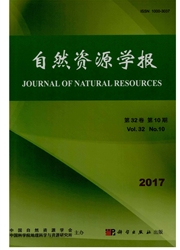

 中文摘要:
中文摘要:
基于国产多源高分辨率卫星数据,利用遥感(RS)、地理信息系统(GIS)、全球定位系统(GPS)技术结合野外勘查的方式,对广西红树林面积进行遥感监测并对其群落类型进行野外勘查。结果表明:截至2013年12月,广西红树林总面积为7 243.15 hm~2,共有斑块2 793个,平均斑块面积为2.59 hm~2,其中最大斑块面积为173.67 hm~2。北海市红树林面积、斑块数及比例分别为3 263.66 hm~2、905个、45.06%;钦州市为2 097.41 hm~2、1 259个、28.96%;防城港市为1 882.08hm~2、629个、25.98%。红树林群落类型有白骨壤、白骨壤+桐花树、桐花树、桐花树+白骨壤、木榄-白骨壤等共21种,其中面积及比例从大到小前7位排列分别是白骨壤群落(3 022.96 hm~2,41.74%)、桐花树群落(2 383.81 hm~2,32.91%)、白骨壤+桐花树群落(405.42 hm~2,5.60%)、木榄-白骨壤群落(303.93 hm~2,4.20%)、红海榄-白骨壤群落(214.43 hm~2,2.96%)、无瓣海桑-桐花树群落(138.46 hm~2,1.91%)、木榄-桐花树群落(128.40 hm~2,1.77%)。通过对比发现,不同研究者、影像数据源和研究方法,会使得同一区域红树林面积监测结果存在较大差异。
 英文摘要:
英文摘要:
Based on the data of multi-source high-resolution satellite imageries, the spatial distribution and the community types of mangroves along the coast in Guangxi were studied using the methods image processing, geographic information systems(GIS), global positioning system(GPS) technology and field investigations. The results showed that there were 7 243.15hm~2 of mangroves in Guangxi in 2013. Totally, 2 793 mangrove patches were found, with the average patch-area of 2.59 hm~2. The area of the largest mangrove patch in Guangxi was 173.67hm~2. The total area and the number of patches of mangrove in Beihai city were 3 263.66 hm~2 and 905 respectively, accounting for 45.06% of mangroves in Guangxi. There were 2 097.41hm~2 in Qinzhou city, which had 1 259 patches and accounted for 28.96% of mangroves in Guangxi. Fangchenggang city had the smallest area of mangroves among the three coastal cities in Guangxi, with 1 882.08 hm~2 in area, 629 patches which accounting for 25.98% of mangroves in Guangxi. Twenty-one types of mangrove communities in Guangxi were identified,including Community Avicennia marina, Community Avicennia marina+Aegiceras corniculatum,Community Aegiceras corniculatum, Community Aegiceras corniculatum + Avicennia marina,and Community Bruguiera gymnoihiza-Avicennia marina, etc. Among them, Community Avicenniat marina(3 022.96 hm~2, 41.74%), Community Aegiceras corniculatum(2 383.81 hm~2,32.91%), Community Avicennia marina + Aegiceras corniculatum(405.42 hm~2, 5.60%),Community Bruguiera gymnoihiza-Avicennia marina(303.93 hm~2, 4.20%), Community Rhizophora stylosa-Avicennia marina(214.43 hm~2, 2.96%), Sonneratia apetala-Aegiceras corniculatum(138.46 hm~2, 1.91%), Community Bruguiera gymnoihiza-Aegiceras corniculatum(128.40 hm~2, 1.77%) were the most dominant mangrove communities. The mangrove area in this study did not consist with the results of other studies, which can be attributed to different research methods and different image data sources.
 同期刊论文项目
同期刊论文项目
 同项目期刊论文
同项目期刊论文
 期刊信息
期刊信息
